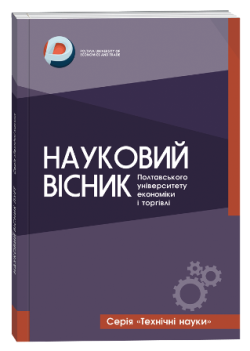THE COMPLETE PROCESSING OF GRAPES FOR ALCOHOLIC AND NON-ALCOHOLIC BEVERAGES
Abstract
The article is devoted to the use of aqueous extracts obtained from juice pomace in the technology of beverage production (juices, soft drinks) as a source of organic acids and biologically active substances. The article is aimed at using extracts from juice pomace in the technology of juice-containing soft drinks. It is known that more than half of primary resources go to waste, which significantly pollutes the environment and changes the composition of air, soil, and water during decomposition or combustion. The reuse of recycled plant materials is of great environmental, economic and technological importance. It has been established that one of the most common methods of extracting nutrients from fruit pomace is extraction. The research was conducted with juice production waste – pomace from blueberries, cranberries and chaenomeles. The study results confirmed that the pomace is a rich source of biologically active substances and should be used in food technology. Water, aqueous solutions of organic acids, and water-alcohol solutions were used as extractants. The optimal conditions for the extraction of fruit pomace were determined. The obtained aqueous extracts of chaenomeles were used as a source of organic acids in the technology of carrot and beet juice production as a substitute for citric and ascorbic acids. Aqueous extracts from blueberries and cranberries are recommended for use in soft drink technology as natural colorants. It has been confirmed that the extracts obtained using juice production waste can be a source of organic acids (extracts from chaenomeles), natural colorants (extracts from blueberries and cranberries) in beverage formulations.
References
2. Сайт журналу. Global Footprint Network. National Footprint Accounts 2018.
3. Коваль, С. О. Вплив на довкілля харчової промисловості. Збірник тез доповідей Ⅷ Міжнародної науково-технічної конференції молодих учених та студентів „Актуальні задачі сучасних технологій “, 2019. Вип. 1, С. 96-96.
4. Bieniasz, M., Dziedzic, E., & Kaczmarczyk, E. The effect of storage and processing on vitamin C content in Japanese quince fruit. Folia horticulturae, 2017. Vol.29(1), Р 83-93.
5. Hummer, K. E., & Janick, J. Rosaceae: taxonomy, economic importance, genomics. Genetics and genomics of Rosaceae. 2009. Р.1-17. DOI: 10.1007/978-0-387-77491-6_1
6. Gorlach, S.; Wagner, W.; Podsędek, A.; Szewczyk, K.; Koziołkiewicz, M.; Dastych, J. Procyanidins from Japanese quince (Chaenomeles japonica) fruit induce apoptosis in human colon cancer Caco-2 cells in a degree of polymerizationdependent manner. Nutr. Cancer 2011, Vol. 63, Р. 1348–1360.
7. Lewandowska, U.; Szewczyk, K.; Owczarek, K.; Hrabec, Z.; Podsędek, A.; Koziołkiewicz, M.; Hrabec, E. Flavanols from Japanese quince (Chaenomeles japonica) fruit inhibit human prostate and breast cancer cell line invasiveness and cause favorable changes in Bax/Bcl-2 mRNA ratio. Nutr. Cancer 2013, Vol. 65, Р. 273–285.
8. Owczarek, K.; Hrabec, E.; Fichna, J.; Sosnowska, D.; Koziołkiewicz, M.; Szymański, J.; Lewandowska, U. Flavanols from Japanese quince (Chaenomeles japonica) fruit suppress expression of cyclooxygenase-2, metalloproteinase-9, and nuclear factor-kappaB in human colon cancer cells. Acta Biochim. Pol. 2017, Vol.64, Р. 567–576.
9. Amić, D.; Davidović-Amić, D.; Beslo, D.; Rastija, V.; Lucić, B.; Trinajstić, N. SAR and QSAR of the Antioxidant Activity of Flavonoids. Curr. Med. Chem. 2007, Vol.14(7), Р.827–845.
10. Apak, R.; Güçlü, K.; Demirata, B.; Özyürek, M.; Çelik, S.; Bektaşoğlu, B.; Özyurt, D. Comparative Evaluation of Various Total Antioxidant Capacity Assays Applied to Phenolic Compounds with the CUPRAC Assay. Molecules. 2007, Vol.12(7), Р.1496–1547.
11. Burda, S.; Oleszek, W. Antioxidant and antiradical activities of flavonoids. J. Agric. Food Chem. 2001, Vol. 49, Р. 2774–2779.
12. Pannala, A.S.; Chan, T.S.; O’Brien, P.J.; Rice-Evans, C.A. Flavonoid B-ring chemistry and antioxidant activity: Fast reaction kinetics. Biochem. Biophys. Res. Commun. 2001, Vol.282, Р. 1161–1168.
13. Procházková, D.; Boušová, I.; Wilhelmová, N. Antioxidant and Prooxidant Properties of Flavonoids. Fitoterapia. 2011, Vol.82(4), Р.513–523.
14. Farhadi, F.; Khameneh, B.; Iranshahi, M.; Iranshahy, M. Antibacterial activity of flavonoids and their structure–activity relationship: An update review. Phytother. Res. 2019, Vol. 33, Р.13–40.
15. Viskelis, P.; Rubinskienė, M.; Jasutienė, I.; Šarkinas, A.; Daubaras, R.; Česonienė, L. Anthocyanins, antioxidative, and antimicrobial properties of American cranberry (Vaccinium macrocarpon Ait.) and their press cakes. J. Food Sci. 2009, Vol.74, Р.157–C161.
16. Puupponen-Pimiä, R.; Nohynek, L.; Alakomi, H.L.; Oksman-Caldentey, K.M. Bioactive berry compounds–Novel tools against human pathogens. Appl. Microbiol. Biotechnol. 2005, Vol.67, Р.8–18.
17. Kikowska, M.; Włodarczyk, A.; Rewers, M.; Sliwinska, E.; Studzińska-Sroka, E.; Witkowska-Banaszczak, E.; Thiem, B. Micropropagation of Chaenomeles japonica: A Step towards Production of Polyphenol-rich Extracts Showing Antioxidant and Antimicrobial Activities. Molecules 2019, Vol.24, Р. 1314.
18. Фенольні сполуки дикорослих плодів і ягід: склад, властивості, зміни при переробці: монографія: Полтава: ПУЕТ, 2013. С. 217.
19. Reque, M.P.; Steffens, S.R.; da Silva, M.A.; Jablonski, A.; Flôres, H.S.; de Rios, O.A.; de Jong, V.E. Characterization of blueberry fruits (Vaccinium spp.) and derived products. Food Sci. Technol. Campinas. 2014, Vol.34, Р. 773–779.
20. He, O.; Zhang, L.L.; Yue, X.Y.; Liang, J.; Jiang, J.; Gao, X.L.; Yue, P.X. Optimization of ultrasoundassisted extraction of phenolic compounds and anthocyanins from blueberry (Vaccinium ashei) wine pomace. Food Chem. 2016, Vol.204, Р.70–76.
21. Melo, S.P.; Massarioli, P.A.; Denny, C.; dos Santos, F.L.; Franchin, M.; Pereira, E.G.; Vieira, T.M.; Rosalen, L.P.; de Alencar, M.S. Winery by-products, extraction optimization, phenolic composition and cytotoxic evaluation to act as a new source of scavenging of reactive oxygen species. Food Chem. 2015, Vol.181, Р.160–169.
22. Klavins, L.; Kviesisa, J.; Nakurteb, I.; Klavins, M. Berry press residues as a valuable source of polyphenolics, extraction optimisation and analysis. Food Sci. Technol. 2018, Vol.93, Р. 583–591.
23. Khomych, G., Krusir, G., Horobets, O., Levchenko, Y., & Gaivoronska, Z. Development of resource effective and cleaner technologies using the waste of plant raw materials. Journal of Ecological Engineering, 2020. Vol. 21(4). р.178-184

